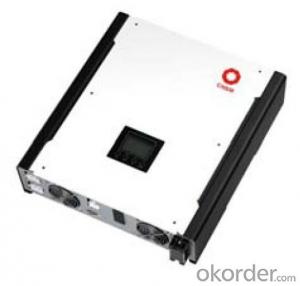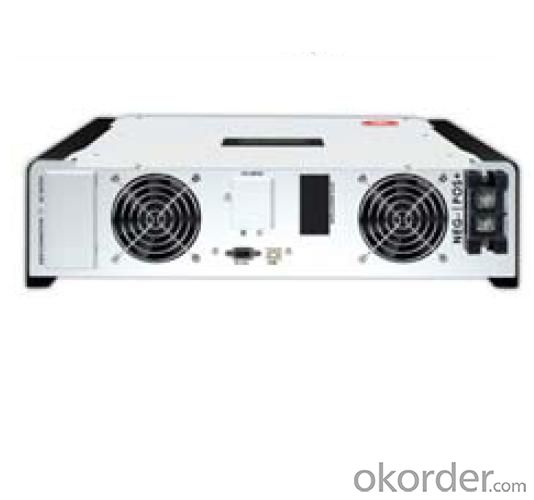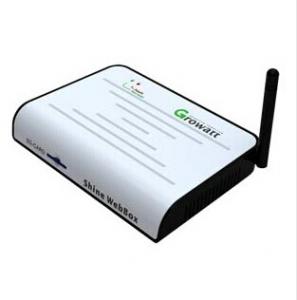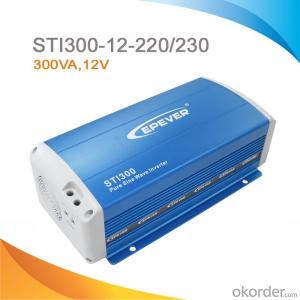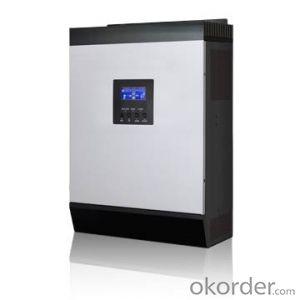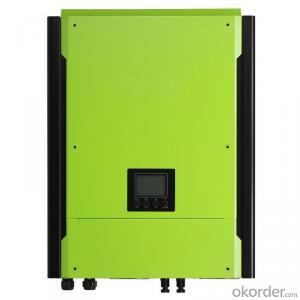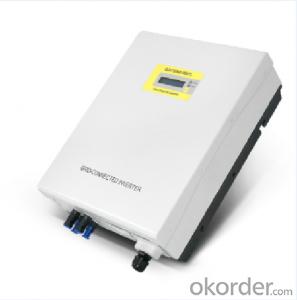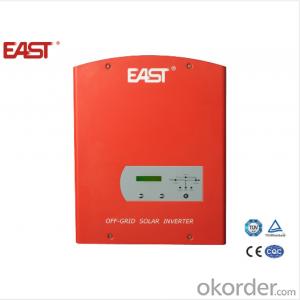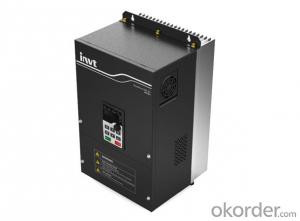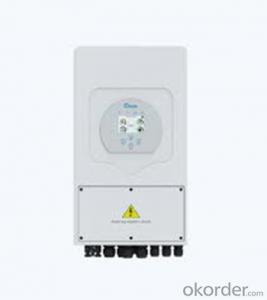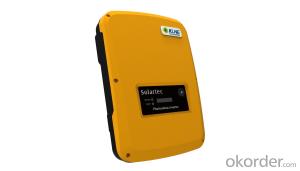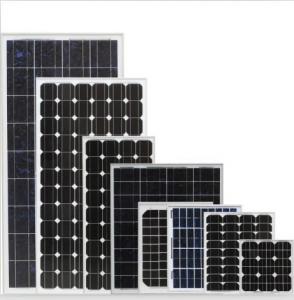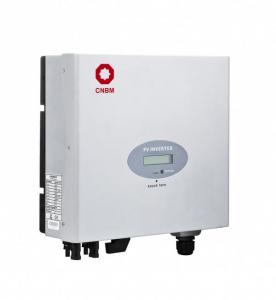12 Kw Solar Inverter Hybrid Inverter Sunbrid 2000 with Full Certificate
- Loading Port:
- Guangzhou
- Payment Terms:
- TT OR LC
- Min Order Qty:
- 10 pc
- Supply Capability:
- 3000 pc/month
OKorder Service Pledge
OKorder Financial Service
You Might Also Like
Sunbrid 2000/3000 hybrid solar inverter can be use as on grid solar inverter or off grid inverter.
1.futures
Multiple operations: Grid-tied, off-grid, and grid-tied with battery backup
•Solar power usage priority selectable
•Built-in MPPT solar charger
•Intelligent control to guarantee stable system charging
•Comprehensive information from LCD display
2.datasheet
| MODEL | Sunbrid 2000 | Sunbrid 3000 |
| RATED POWER | 2000 W | 3000 W |
| GRID-TIE OPERATION | ||
| PV INPUT (DC) | ||
| Nominal DC Voltage | 300 VDC | 360 VDC |
| Maximum DC Voltage | 350 VDC | 500 VDC |
| Start-up Voltage / Initial Feeding Voltage | 80 VDC / 120 VDC | 116 VDC / 150 VDC |
| MPP Voltage Range | 120 VDC ~ 320 VDC | 120 VDC ~ 450 VDC |
| Maximum Input Current | 15 A | 13 A |
3.product certificate
CE,
ISO2000
TUV
4.product outlook
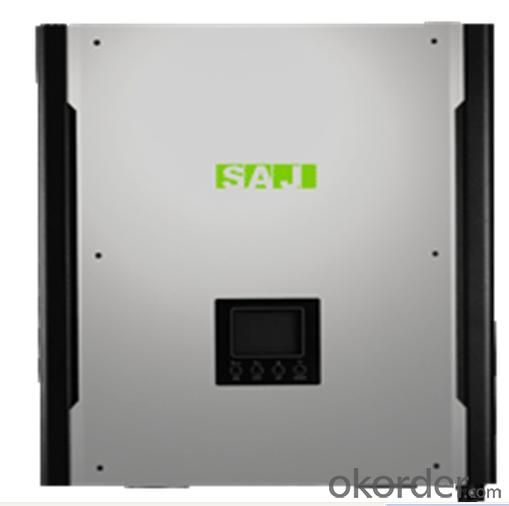
FAQ
1. How long will my inquiry get response?
Your inquiry related to our products or prices will be replied within 24 hours.
2. Can I get professional service and suggestion?
Well-trained and experienced staffs to answer all your questions in fluent English.
3. Do you accept OEM or customized design?
OEM & ODM, any your customized lightings we can help you to design and put into product.
4. What if I need specific design?
Distributorship are offered for your unique design and some our current models.
- Q: Are there any noise or sound considerations with a solar inverter?
- Yes, there are noise considerations with a solar inverter. While solar inverters generally produce low levels of noise, there can be some audible humming or buzzing sound generated during their operation. The noise level can vary depending on the type and model of the inverter. However, modern inverters are designed to minimize noise and are generally considered to be quiet during normal operation.
- Q: What are the potential risks of electrical shock from a solar inverter?
- The potential risks of electrical shock from a solar inverter include: 1. Improper installation or faulty wiring, which may result in exposed live wires and increase the chances of electric shock. 2. Inadequate grounding or lack of proper safety measures, leading to the possibility of electrical leakage and shock hazards. 3. Accidental contact with energized components during maintenance or repair work, especially if proper safety precautions are not followed. 4. Inverter malfunctions or defects, such as insulation breakdown, which can expose individuals to electric shock. 5. Working with solar inverters in wet or damp conditions, as moisture can increase the conductivity of electricity and heighten the risk of shock. 6. Ignoring warning signs or not following manufacturer guidelines for safe operation and maintenance, which can contribute to electrical shock incidents.
- Q: What is the role of a power quality analyzer in a solar inverter?
- The role of a power quality analyzer in a solar inverter is to measure and analyze various parameters of the electric power being generated by the solar panels. It helps in monitoring the quality of the power, such as voltage levels, frequency, harmonics, and power factor, to ensure that it meets the required standards and is suitable for efficient operation of the solar inverter. By providing detailed information on the power quality, the analyzer helps in identifying any issues or anomalies in the power output and allows for necessary corrective actions to be taken, thereby optimizing the performance and reliability of the solar inverter system.
- Q: How is the output voltage of a solar inverter regulated?
- The output voltage of a solar inverter is regulated through a combination of voltage control algorithms and power electronics components. These algorithms continuously monitor the voltage level and adjust the inverter's operation accordingly to maintain a stable output voltage. Additionally, power electronics components like DC-DC converters and inverters are used to convert the variable DC voltage generated by the solar panels into a stable AC voltage output that matches the grid requirements.
- Q: Can a solar inverter be used in conjunction with a power factor correction device?
- Yes, a solar inverter can be used in conjunction with a power factor correction device. Power factor correction devices are designed to improve the power factor of electrical systems by reducing reactive power and improving overall efficiency. Since solar inverters convert DC power from solar panels into AC power for use in electrical systems, they can benefit from the use of power factor correction devices to optimize power quality and reduce energy waste. By combining a solar inverter with a power factor correction device, both the generation and consumption of electricity can be more efficient and environmentally friendly.
- Q: How does a solar inverter handle voltage regulation during sudden load changes?
- A solar inverter handles voltage regulation during sudden load changes by continuously monitoring the grid frequency and voltage. When there is a sudden load change, the inverter adjusts its power output accordingly to maintain a stable voltage level. It does this by dynamically controlling the power conversion process, regulating the flow of electricity from the solar panels to the grid. This ensures that the voltage remains within the acceptable range even during sudden changes in load demand.
- Q: Can a solar inverter be used in regions with high levels of dust or debris?
- Yes, a solar inverter can be used in regions with high levels of dust or debris. However, it is important to regularly clean and maintain the inverter to ensure optimal performance and prevent any damage caused by the accumulation of dust or debris.
- Q: Can a solar inverter be used with different AC voltages?
- Yes, a solar inverter can be used with different AC voltages. However, it is important to ensure that the inverter is compatible with the specific AC voltage and frequency requirements of the power grid it will be connected to.
- Q: What are the common fault indications in a solar inverter?
- Some common fault indications in a solar inverter include error codes displayed on the inverter's screen, abnormal or fluctuating power output, frequent tripping or shutting down of the inverter, unusual noises or vibrations, and failure to connect or communicate with the monitoring system. These fault indications often suggest issues such as overheating, overvoltage, overcurrent, ground faults, or component failure within the inverter.
- Q: Can a solar inverter be used in a floating solar system?
- Yes, a solar inverter can be used in a floating solar system. In fact, a solar inverter is an essential component of any solar power system, including floating solar systems. The purpose of a solar inverter is to convert the direct current (DC) electricity produced by the solar panels into alternating current (AC) electricity that can be used to power electrical appliances or be fed into the grid. Whether the solar panels are installed on the ground, on rooftops, or on a floating platform, a solar inverter is necessary to ensure the efficient and safe conversion of solar energy into usable electricity.
Send your message to us
12 Kw Solar Inverter Hybrid Inverter Sunbrid 2000 with Full Certificate
- Loading Port:
- Guangzhou
- Payment Terms:
- TT OR LC
- Min Order Qty:
- 10 pc
- Supply Capability:
- 3000 pc/month
OKorder Service Pledge
OKorder Financial Service
Similar products
Hot products
Hot Searches
Related keywords
